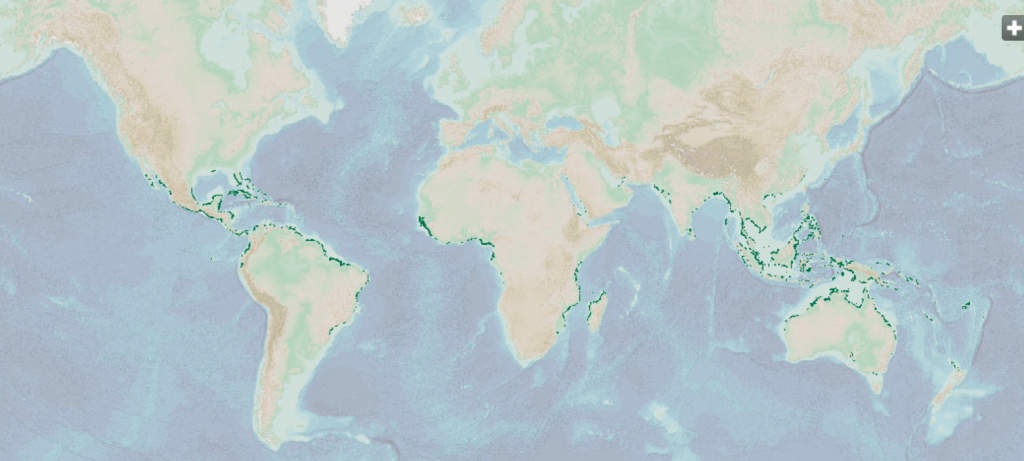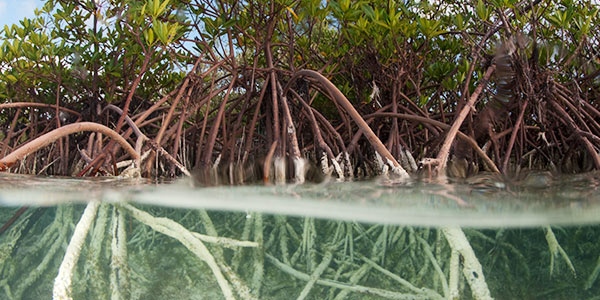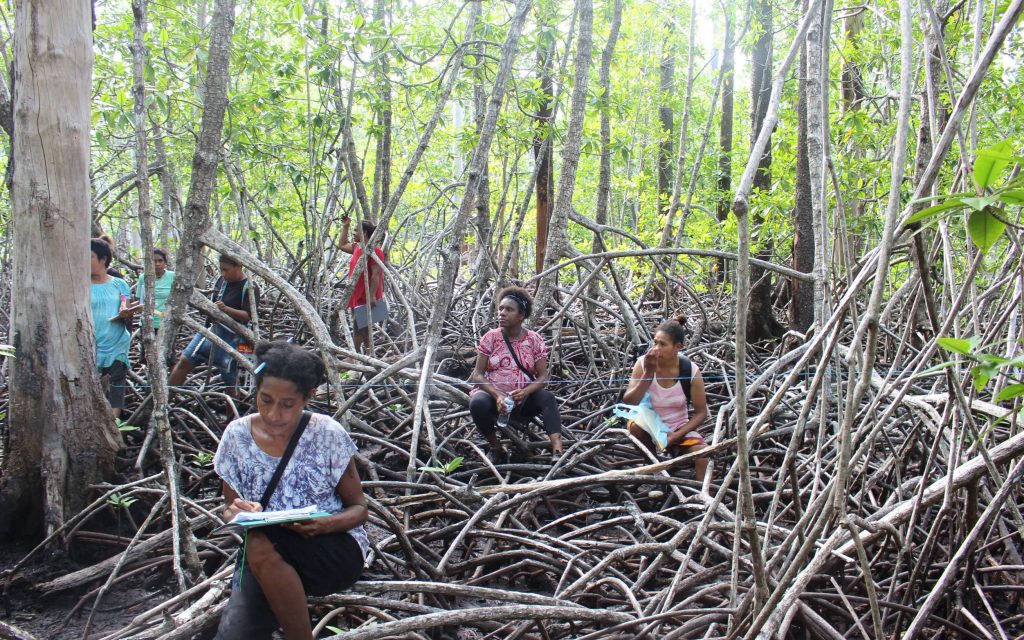
Facebook Twitter Instagram YouTube RSS Feed
Written on: September 22nd, 2023 in Natural Resources, Outreach
By Olivia Allread, DNREC’s Wetland Monitoring and Assessment Program
Magical forest, walking trees, mangals, snorkeling roots – this habitat can be called by many names. With a worldwide distribution in tropical to warm temperature latitudes, mangrove forests are not only incredible ecosystems, but a key player in climate resiliency and human livelihood. If you’ve been to the lower half of the United States, specifically southern Florida and the Gulf Coast of Texas, you may have come across this type of coastal wetland. If you’re more of a world traveler, it’s likely you may encounter a mangrove along your journey, as these wetlands reside on five out of seven continents on the globe.
Let’s get to know mangrove forests from root to tip. These coastal wetlands consist of groups of shrubs and trees that are uniquely adapted to estuarine tidal and marine conditions. Living in these ecosystems means that mangroves must be able to survive not only in waterlogged soils with oxygen-poor sediment, but also in saltwater experiencing daily tidal cycles. In order to grow in such harsh conditions, the roots are often sprawled above the water and below in sediment – a bit different than most plants. Along with the unique structure of their roots, mangroves can also filter out the salt from water as it enters their roots by secreting salt out of special glands on the leaves. This dynamic duo of adaptations allows the flowering part of the plant (the branches and leaves) to live above the water line, while the above and below ground root system maintains stability under the water.
When it comes to overcoming growth challenges, mangroves have really thought this one through. Regular coastal flooding can make most plants reproduction a more than difficult task. However, mangroves have adapted to use the tides and proximity to waves to their advantage through vivipary. This simply means that the offspring begin to grow while still attached to their parent plant, and in this case, far above the salt water. After pollination and germination, the seedlings fall into the water to then be swept away by the tides and wave action nearby. Next stop, the bottom of a muddy tidal wetland to grow out of the water and hopefully play a role in another mangrove colony.
According to The Nature Conservancy, there are approximately 70 species of trees and shrubs that make up mangrove plants communities of the world. Chilly or freezing waters are a big no no for mangroves, so it’s not a surprise that their distribution is only in tropical and subtropical latitudes near the equator. The various species across the globe are not necessarily closely related but do all share the distinct capability of growing dense roots out of the water in salty and often unstable conditions. For us here in continental United States, only three species of mangrove grow: black, red, and white mangroves.


Now, we’ve discussed the benefits and necessity for coastal wetlands on our blog before. But in standard fashion, each wetland habitat comes with its own intricate set of ecological and societal benefits. The fact that mangroves thrive in such harsh conditions is already remarkable; below are even more reasons to give them credit.
Habitat and Biodiversity
A mangroves maze of woody roots creates an intricate network of available habitat for numerous plants and animals. They are dense aquatic forests, a few miles in size, that provide areas for migratory birds, exotic fish and reptiles, heathy trees, and even furry friends like lemurs and panthers. As a nursery habitat, many small fish and invertebrates such as crabs and shrimp grow safely in mangroves and later move on to open water areas such as coral reefs. Recent data from The Nature Conservancy shows that mangroves are home to 341 internationally threatened species. And if you haven’t recognized their wonder yet, just Google a sloth swimming in a mangrove to really see the “wow factor”.
Blue Carbon Sequesters
Like all trees, especially in wetlands, mangroves absorb and store carbon from the atmosphere. What sets these habitats apart from the rest is how they store it. Once leaves and older trees die in a mangrove forest, they fall into the water and take the stored carbon with them to be buried in the soil. This is what we call “blue carbon” because it is stored underwater in the coastal ecosystem. Storing substantial amounts of carbon has proven to offset carbon emissions that drive the current climate crisis. The Smithsonian Ocean predicts one acre of mangrove forest can store about 1,450 pounds of carbon per year – roughly the same amount emitted by a car driving straight across the United States and back. Another reason to love mangroves and wetlands; they keep our air cleaner.


Coastline Protectors
This is a big one. Mangroves protect our shorelines and coastal areas more than we can imagine. As natural infrastructure, they provide protection to populated coastal areas by reducing flood impacts and property damages during extreme weather events. Mangrove forests buffer wave and wind energy as a first line of defense during strong storms. Also, their dense, aboveground roots slow down water flow and hold deposited sediment in place mitigating impacts from sea level rise. Last, their complex, underground root systems help cycle and filter excess nutrients reducing pollution and improving water quality.
Recreation and Culture
It’s a universal truth; the outdoors can bring people joy. Kayaking, snorkeling, fishing, birding, the list goes on. Mangroves can provide an invaluable natural experience because of their biodiversity and geographic location in some of the most tropical places on Earth. In addition to the everyday recreation, the traditional use of mangrove habitats dates to the BC times. These highly sustainable practices for hunting, timber, and food production are still in use today in some South American and African countries but may be lost with ecosystem degradation. The livelihoods of coastal cultures worldwide have become intertwined with mangrove forests whether it be through living spaces to nature clubs, small scale businesses to historic heritage sites.
Like many coastal ecosystems, these habitats unfortunately face a variety of threats and are being lost at a rapid rate. Whether experiencing habitat destruction from human impact like aquaculture or development, threats from sea level rise, damages from coastal storms and flooding – mangroves are up against some tough odds. The hard times of the modern age have brought on bigger and better ideas in conservation for mangroves, but all the answers are not clear yet. Science and education, reforestation projects, monitoring, policy adaptation – these are some of the ingredients to the recipe for success. But if there is a future for mangrove forests in our world, it may be useful to look at them as part of the solution. After all, they are masters at adaptation and overcoming intense challenges daily. From The Sundarbans of India and Bangladesh to the Galapagos Islands and The Everglades in southern Florida, mangroves are wetland wonderlands like no other.